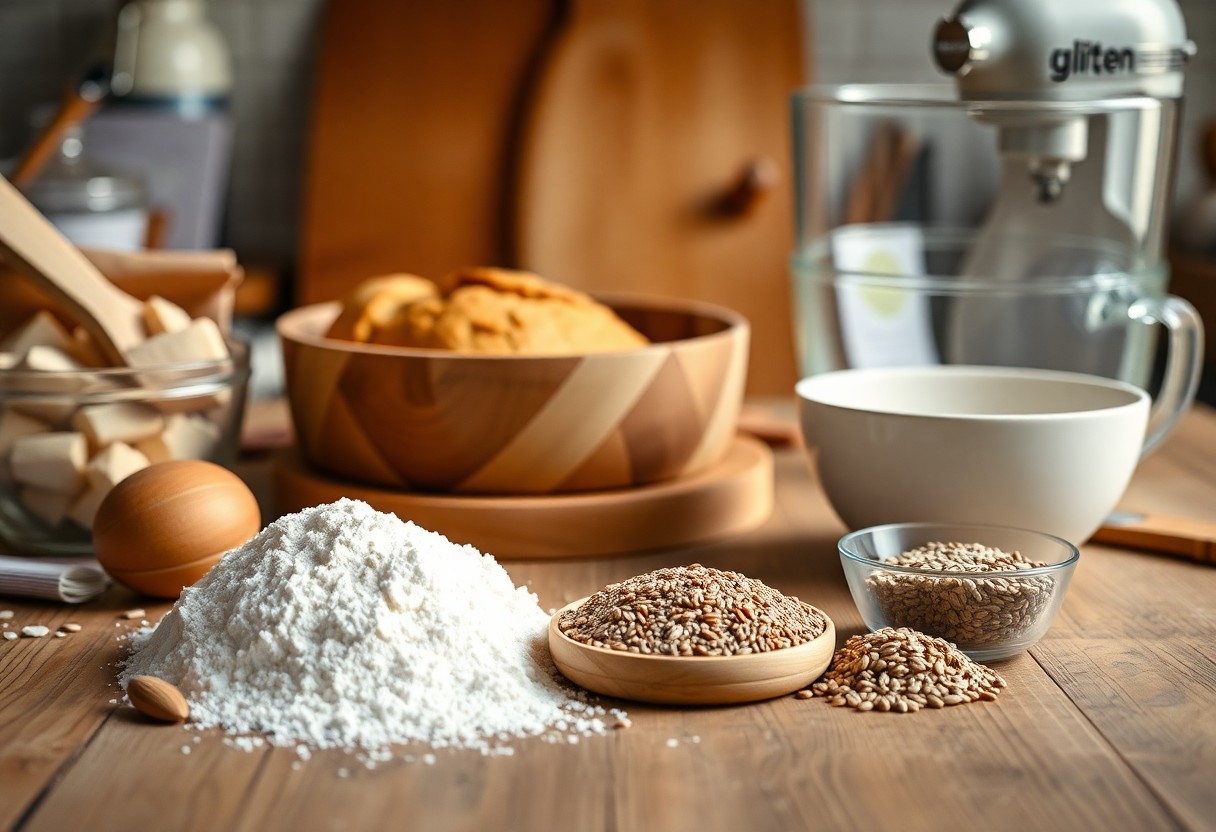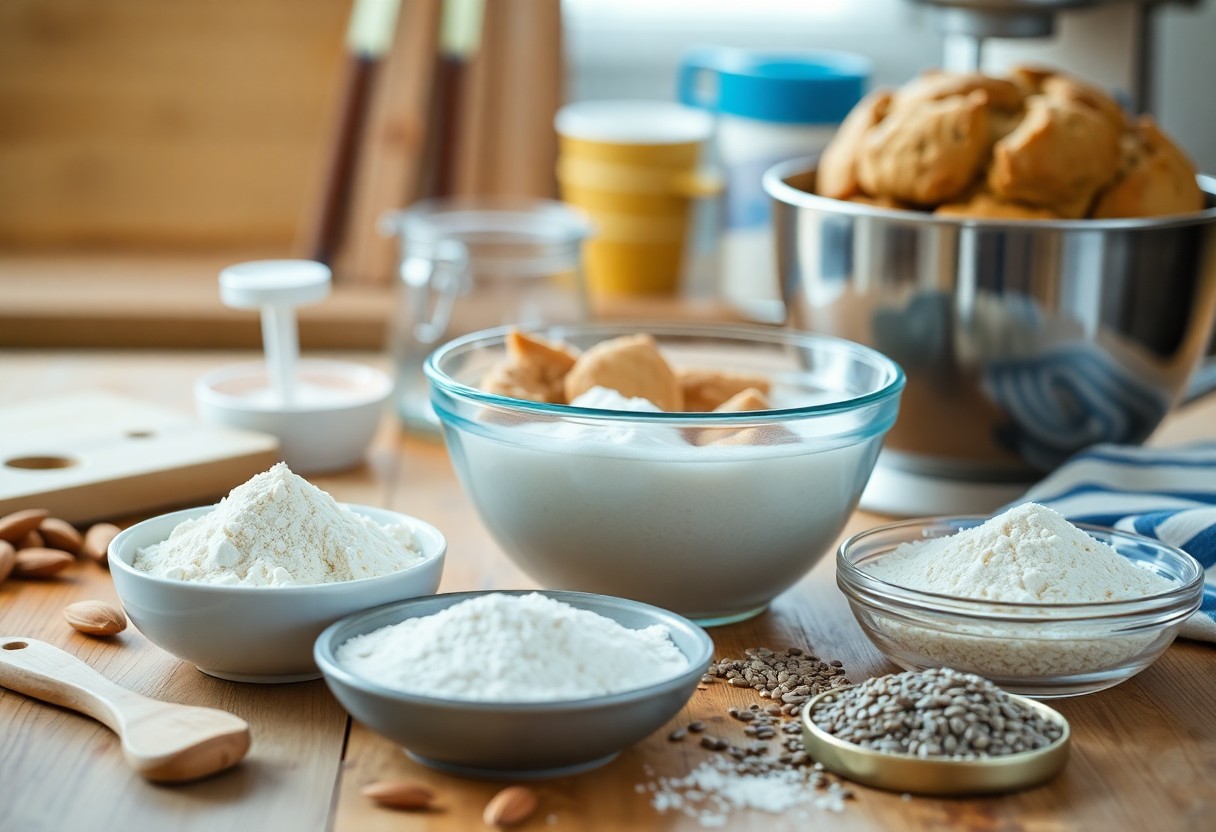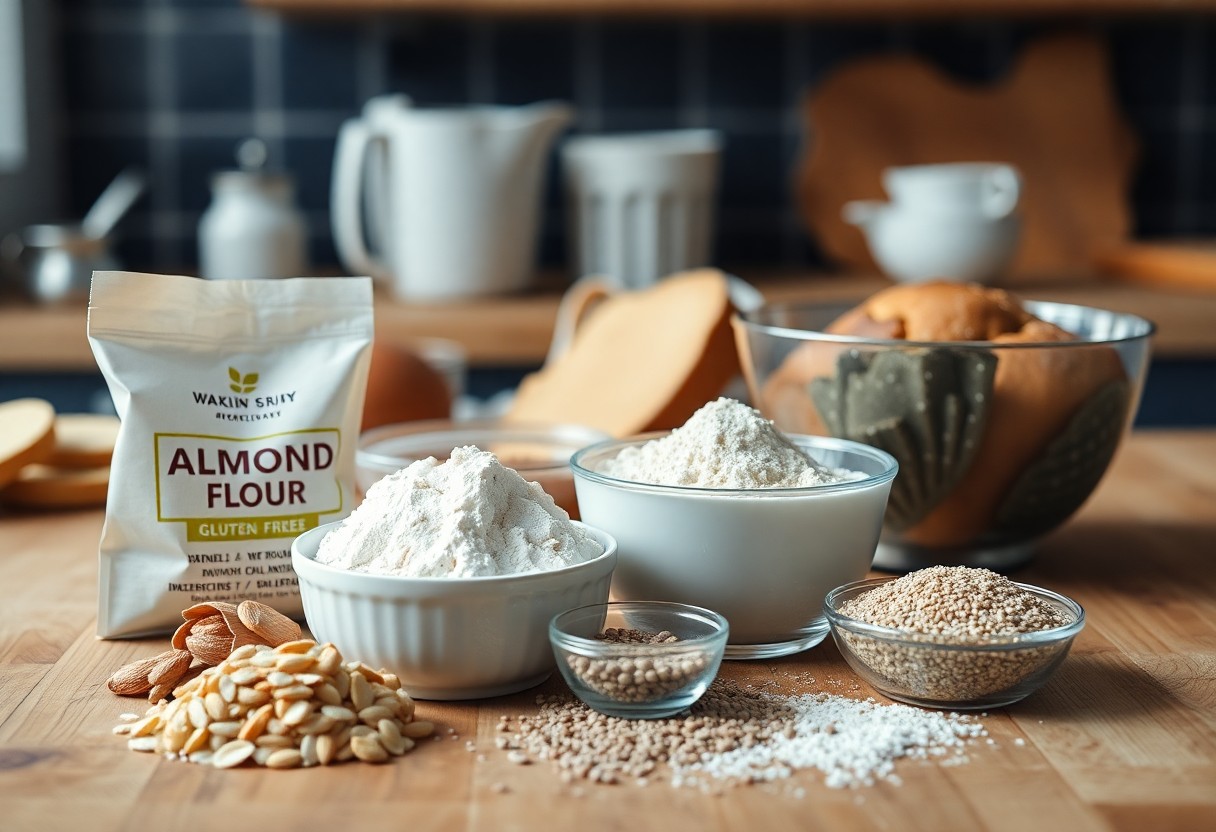What’s the Best Way to Bake Without Gluten?
There’s no need to give up your favorite baked treats when going gluten-free. Whether you’re dealing with celiac disease or choosing to eliminate gluten from your diet, mastering gluten-free baking can open up a world of delicious possibilities. You’ll discover that successful gluten-free baking requires more than just swapping regular flour for alternatives – it’s about understanding how different ingredients work together. With the right combination of flours and a few adjustments to your technique, you can create baked goods that are just as tasty as their traditional counterparts.
Types of Gluten-Free Flours
To achieve successful gluten-free baking, understanding different flour options is important. The market offers various alternative flours derived from grains, nuts, and starches. Though each type brings unique properties to your baking, combining several varieties often yields the best results. Proper storage and measuring techniques are vital for consistent outcomes.
| Flour Type | Best Used For |
|---|---|
| Almond Flour | Cookies, Cakes |
| Rice Flour | General Baking |
| Coconut Flour | Dense Baked Goods |
| Tapioca Flour | Thickening, Binding |
| Chickpea Flour | Savory Baking |
Common Gluten-Free Flours
An array of readily available options includes almond, rice, and coconut flour. These versatile ingredients form the foundation of your gluten-free pantry. You’ll find these flours in most supermarkets, making them convenient choices for your everyday baking needs.
Specialty Gluten-Free Flours
GlutenFree baking elevates with specialty flours like teff, sorghum, and amaranth. These unique ingredients add distinctive flavors and nutritional benefits to your baked goods. Though less common, they’re worth exploring for their exceptional qualities.
With specialty flours, you can expand your baking horizons significantly. Teff flour brings a nutty flavor and high protein content, while sorghum flour offers a mild taste perfect for delicate pastries. Your experimentation with these ingredients can lead to remarkable results in texture and taste.
Tips for Baking Without Gluten
Assuming you’re new to gluten-free baking, understanding the fundamentals will set you up for success. Proper measuring techniques and temperature control are important elements of gluten-free baking. You’ll need to adapt your traditional recipes by using xanthan gum or other binding agents to replicate gluten’s structure. Recognizing that gluten-free flours behave differently than wheat flour will help you adjust your expectations and techniques accordingly.
Essential Ingredients
Assuming you want to start your gluten-free baking journey, stock your pantry with these fundamental ingredients. Your basic toolkit should include rice flour, almond flour, and tapioca starch as primary alternatives. A quality all-purpose gluten-free flour blend can simplify your baking process. You’ll also need binding agents like xanthan gum or psyllium husk to provide structure to your baked goods.
Substitutions and Adjustments
While converting traditional recipes to gluten-free versions, you’ll need to make specific adjustments. Your recipes may require additional moisture as gluten-free flours typically absorb more liquid. You can enhance texture by adding extra eggs or increasing fat content. Consider incorporating protein-rich ingredients like quinoa flour to improve structure.
Another important aspect of gluten-free baking is understanding the role of different flour combinations. You can achieve better results by mixing light starches with heavier grain-based flours. Your baked goods will benefit from combining different protein contents – aim for a mix of 60% whole-grain flours and 40% starches. Avoid overmixing your batters as this can lead to gummy textures.
Step-by-Step Guide to Gluten-Free Baking
Some of the most successful gluten-free baking experiences come from following a systematic approach. You’ll need to understand the proper ratios and techniques specific to gluten-free ingredients to achieve optimal results.
| 1. Measure ingredients by weight | 2. Bring ingredients to room temperature |
| 3. Mix dry ingredients thoroughly | 4. Don’t overmix the batter |
Preparing Your Ingredients
Baking with gluten-free ingredients requires precise measurements and proper preparation. You’ll want to ensure all your ingredients are at room temperature before starting. This helps create a smoother mixture and better texture in your final product.
Mixing and Baking Techniques
Mixing gluten-free batters requires a different approach than traditional baking. You’ll need to avoid overmixing, which can lead to a gummy texture. Instead, mix until the ingredients are just combined.
With gluten-free baking, you’ll find that timing is everything. Your batters might look different from traditional ones – often appearing thicker or grainier. You should watch for visual cues rather than relying solely on suggested baking times, as gluten-free goods can bake faster than their wheat-based counterparts.
Key Factors to Consider
For successful gluten-free baking, you need to understand several imperative elements. Temperature control, ingredient ratios, and mixing techniques play vital roles in achieving the right texture and taste. Your choice of alternative flours and binding agents will significantly impact the final result. This knowledge will help you create baked goods that rival their gluten-containing counterparts.
Understanding Gluten-Free Recipes
Now you’ll need to familiarize yourself with the unique properties of gluten-free ingredients. Xanthan gum and psyllium husk serve as imperative binders in your recipes. Your success depends on understanding how different flour combinations work together – rice flour provides structure, while almond flour adds moisture. This foundation will guide you in selecting the right ingredients for your specific baking needs.
Measuring and Mixing Differences
Now you must adapt your traditional baking methods for gluten-free success. Weight measurements are more accurate than volume measurements when working with gluten-free flours. Your mixing time will typically be shorter than with regular flour, and over-mixing can lead to gummy textures. This precision in measurement and mixing technique will help ensure consistent results.
Recipes requiring gluten-free ingredients demand careful attention to detail. You’ll find that gluten-free batters often appear thicker than traditional ones. Your dough might feel stickier and require additional resting time. Adding ingredients gradually and maintaining proper temperature control will help prevent common issues like grittiness or crumbling. This methodical approach will help you achieve the texture you’re looking for in your baked goods.
Pros and Cons of Gluten-Free Baking
Keep in mind that gluten-free baking brings both opportunities and challenges to your kitchen adventures. Your success depends on understanding these contrasting aspects and adapting your techniques accordingly.
| Suitable for celiac disease | More expensive ingredients |
| Healthier digestion | Complex mixing process |
| Lower inflammation | Different texture outcomes |
| Weight management | Shorter shelf life |
| More nutritious alternatives | Longer preparation time |
| Diverse ingredient options | Steeper learning curve |
Advantages of Gluten-Free Ingredients
Little do you know that gluten-free ingredients can offer superior nutritional benefits compared to traditional flour. Your baked goods can become protein-rich powerhouses when you incorporate alternatives like almond flour, quinoa flour, or chickpea flour, providing better energy levels and improved digestion.
Challenges of Gluten-Free Baking
Cons of gluten-free baking include the need for precise measurements and specific ingredient combinations. Your recipes might require multiple types of flour to achieve the right texture, and some ingredients can be significantly more expensive than traditional options.
Challenges in gluten-free baking extend beyond simple substitutions. You’ll need to master the art of combining xanthan gum or psyllium husk to replicate gluten’s binding properties. Your baked goods might have a different texture, and you’ll need to adjust your expectations while learning to work with these unique ingredients.
Common Mistakes to Avoid
Now that you’re venturing into gluten-free baking, being aware of potential pitfalls will help you achieve better results. From measuring ingredients to temperature control, precision is vital in gluten-free baking. Your success depends on understanding these common errors and knowing how to prevent them.
Ingredient Miscalculations
To achieve the perfect texture in your gluten-free bakes, accurate measurements are non-negotiable. Unlike traditional baking, where you might get away with eyeballing ingredients, gluten-free recipes require exact proportions. Your best approach is to use a kitchen scale rather than cup measurements, as different gluten-free flours have varying weights and densities.
Incorrect Oven Temperatures
| Breads and Rolls | 375-400°F |
| Cakes and Muffins | 350-375°F |
| Cookies | 325-350°F |
| Pizza Crust | 425-450°F |
| Too Hot | Risk of dry, crumbly texture |
| Too Cold | Dense, gummy interior |
| Uneven Heat | Inconsistent results |
| Rapid Temperature Changes | Collapse of structure |
Final Words
Now you have the necessary knowledge to create delicious gluten-free baked goods that rival their traditional counterparts. By selecting the right flour blends, incorporating xanthan gum, and adjusting your mixing techniques, you’ll achieve the perfect texture and taste. Your success in gluten-free baking depends on measuring ingredients precisely and understanding how different flours work together. As you experiment with these methods, you’ll discover that gluten-free baking isn’t limiting – it’s an opportunity to explore new flavors and textures in your culinary journey.







